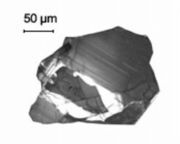 A piece of zircon estimated to be the oldest object on Earth |
The oldest minerals found so far are zircons from Jack Hills in the Narryer Gneiss Terrane, Yilgarn Craton, Western Australia, with an age of 4.404 billion years. This age is interpreted to be the age of crystallization. These zircons might not only be the oldest minerals on earth, they also show another interesting feature. Their oxygen isotopic composition has been interpreted to indicate that more than 4.4 billion years ago there was already water on the surface of the Earth. This is a spectacular interpretation that has been published in top scientific journals but is currently the subject of debate. It may be that the oxygen isotopes, and other compositional features (the rare earth elements), record more recent hydrothermal alteration of the zircons rather than the composition of the magma at the time of their original crystallization.